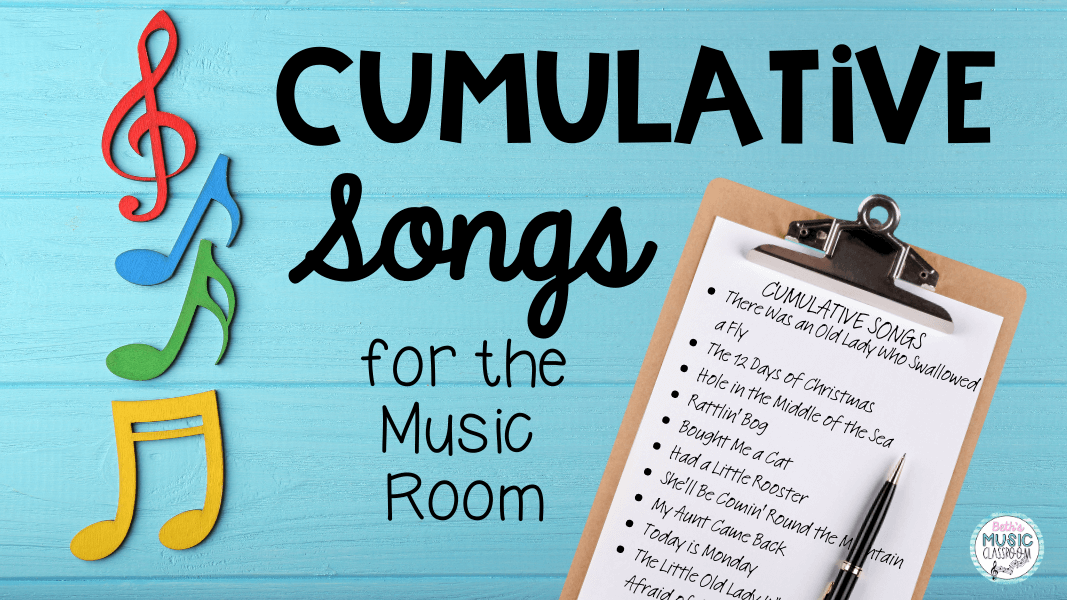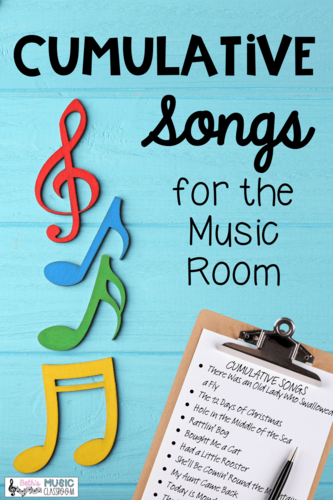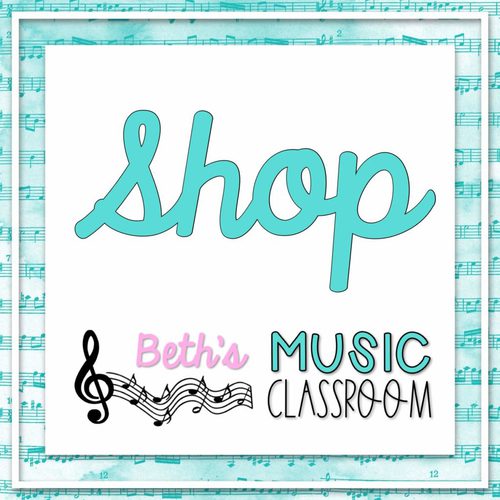Cumulative Songs for Elementary Music

Cumulative Songs for the Music Room
As I think back to my favorite songs as a child, they were all ones that just went on and on with silly lyrics and fun motions. They were cumulative songs. I have memories of singing “Father Abraham” in Sunday School, “The Green Grass Grows All Around” in the car with my family, and lots more. Nowadays, I love adding cumulative songs to my music lessons for a variety of reasons.
What are Cumulative Songs?
If you’re not sure what I’m talking about, cumulative songs are those that keep adding onto the end with a new verse or phrase – it keeps growing. In this post, I am excited to share several of my favorite cumulative songs for elementary music class. But first, I want to start by talking about why I teach them and the many benefits of using this type of song.
Cumulative songs are definitely attention-getters because they often have silly lyrics. This grasps students’ attention and keeps them interested and intrigued in activities with these songs. Another benefit is that they are easy to teach young students because they are so repetitive. Plus, the long list of items named in each cumulative song encourages active listening and memorization. Students could also create their own lyrics or add a few on to the end of the cumulative list. Additionally, with the phrases and words growing each verse, proper breath control is necessary.
All of these benefits coupled with the fact that my kids plain love them inspires me to teach cumulative songs to elementary students each year.
Cumulative Songs for August through December
My first cumulative song of the school year (and probably my favorite) is “There Was an Old Lady Who Swallowed a Fly.” Each September I have a blast teaching it to my kindergarten classes. I have students see how many of the animals they could list on their own after listening to the song. Then we also discuss what other animals she could have swallowed and recognize that each animal kept getting bigger and bigger.
My students love when I pull out my old lady doll and bean bag props! I also have a coloring sheet and paper bag craft that students can make at home.
This one is a great cumulative song for kindergarten to use when discussing real vs. silly songs, steady beat, and tempo. Later in 2nd grade, I use it again for vocal timbre listening and distinguishing between voices of men, women, and children.
At the beginning of the school year, I also love using music videos from Laurie Berkner, who actually has quite a few cumulative songs. My kindergarten and preschool students just love them, especially the song “Waiting for the Elevator.” It has a very simple cumulative part for each of the animals’ sound effects.
Next, I love using the book “The Old Lady Who Wasn’t Afraid of Anything” as a wonderful cumulative story, just perfect for fall and Halloween fun. I add a different classroom percussion instrument to match each of the sound effects that the old lady heard in the woods (i.e. clomp, wiggle, shake, etc.). You could also choose to add body percussion or motions for this activity.
Next, the “12 Days of Christmas” is a well-known holiday song that could also include instrument playing. The repeated verses and large list of items makes it easy to include lots of instruments.
I have also used this melody to “The 10 Days of Thanksgiving,” by Rachel Rambach. Plan out what instrument would work the best for each day/food and tell students on what word they should play.
Cumulative Songs for January through June
Right after the holiday break, I like to use an upbeat and active cumulative song to get them moving. “My Aunt Came Back” and “One Finger, One Thumb” are two great ones for a little brain break. Also, “Johnny Works with One Hammer” works well. It is cumulative in the body movements, rather than in the lyrics or melody.
For March and April, the cumulative songs I use are “Rattlin’ Bog” for St. Patrick’s Day and “The Green Grass Grows All Around” for springtime. For both of these, you can help students write additional lyrics to add to the list. I also love using classroom percussion instruments with them. It works well because students can sing along while still playing their simple instrument parts. Check out how I use “Rattlin Bog” with my K-2 students here.
Each May with my kindergarten classes, I have a farm-themed lesson day where every song, game, and dance has to do with a farm or animals. They love it! Anyway, there are two cumulative songs that fit in this farm theme – “I Had a Little Rooster” and “Bought Me a Cat.” Also, some versions of “Old McDonald Had a Farm” will include a cumulative part for each of the animals’ sounds.
For the three songs listed above, each verse that is added presents a new animal. So after I teach the melody of the song, I designate each student to play a particular instrument which represents an animal. Then as we sing the song together, students play every time they hear their animal.
Finally, towards the end of the school year, I have a few cumulative song favorites on my list. Each of these have to do with traveling, vacation, or places you may go over the summer.
- “We All Go Traveling By” – instruments
- “Once An Austrian Went Yodeling” – motions
- “Hole in the Middle of the Sea” – lyric exploration or instruments
- “She’ll Be Coming Round the Mountain” – sounds, motions, or instruments
Benefits of Using Cumulative Songs
Cumulative songs are such a great choice for kindergarten students, especially early on in the school year. When using instruments with the song, they help students learn not only when to play, but when not to play as well. This self-control is crucial to learn early on in the school year, and cumulative songs can help with this. Also, they encourage singing with simple, repetitive melodies.
I hope that you’ll give some of these exciting cumulative songs a try with your elementary students. Let me know – I’d love to hear how they went! You can find me on Instagram (@bethsmusicclassroom) or email me at beth@bethsmusicclassroom.com.
If you’re looking for some more elementary music activities, check out this post on exciting chants to use in your classroom.

Cumulative Songs for the Music Room

